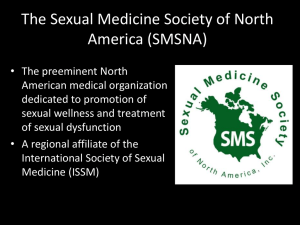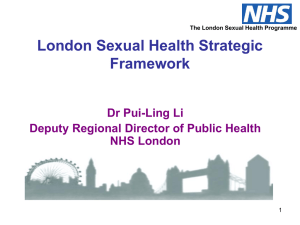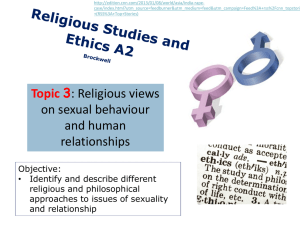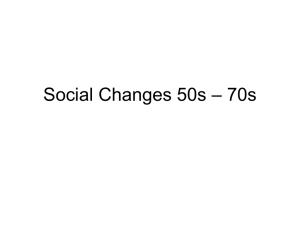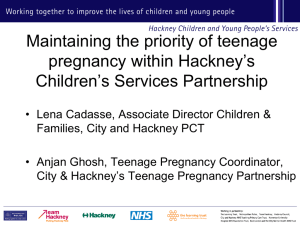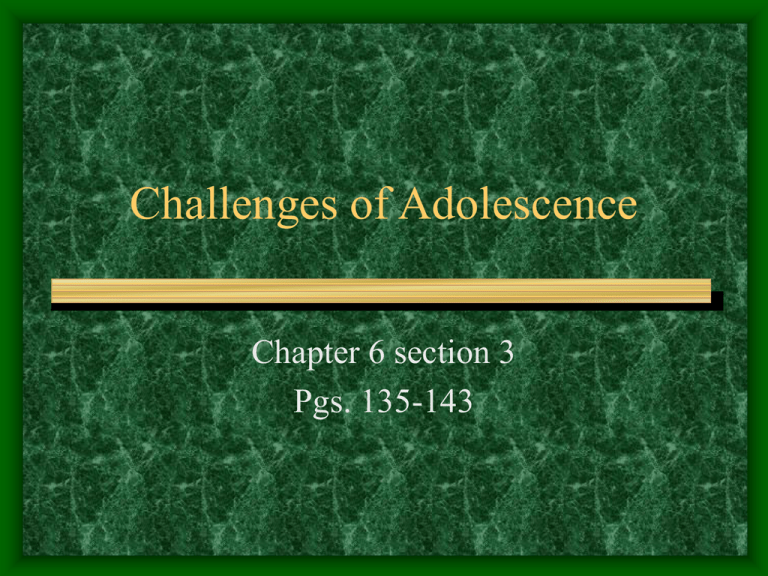
Challenges of Adolescence
Chapter 6 section 3
Pgs. 135-143
Challenges of Adolescence
• The characteristics of adolescence that mark it as a
distinct life stage gave rise to pressures and
problems not generally found in childhood.
• Teenagers face important developmental tasks
which include carving out an identity, planning for
the future, becoming independent, and developing
close relationship.
• Research has focused on the problems that
teenagers face.
– Sexual behavior
– Drug abuse
– Suicide
Teenage Sexual Behavior
• The norms governing
• Traditional sexual
sexual behavior vary
widely from society to
society.
• In western countries,
traditional sexual
values include strict
norms against
premarital sexuality.
values in the U.S. are
an outgrowth of
Puritan and Victorian
views of sexual
morality.
• According to these
views, sexual activity
should be confined to
marriage.
Teenage Sexual Behavior
• In the 60’s and 70’s the development of birth
control, a youth counterculture, and the feminist
movement led to what is known as the Sexual
Revolution.
• The norms regarding sexuality began to change
and people began to discuss the topic openly, as a
consequence sexuality became a familiar feature
in American culture.
Teenage Sexual Behavior
• Sexual references are
• As a consequence
common in the
programs see in the 98
percent of American
households that own
television sets.
• In addition advertisers
have been using the
lure of sexuality to sell
their products.
there has been a
dramatic increase in
adolescent sexual
behavior.
• As a result social
scientists have begun
to study the topic
The Rate of Teenage Sexual
Activity
• According to the CDC…
– IN 1970 29% of unmarried women were
sexually active by 1995 the rate was up to 50%.
– The CDC programs encourage American
teenagers to abstain from sexual activity until
marriage.
• Social scientists have developed a number of
explanations for why adolescents engage in sexual
activity.
Influences on Early Sexual
Activity
• Several factors can
• Religious participation
lead to early sexual
activity.
– Teenagers who actively
participate and practice
their religion tend to
wait until marriage and
have different views on
sexual activity.
–
–
–
–
–
Family income level
Parents marital status
Religious participation
Peer Pressure
Drug Use
Consequences of Early Sexual
Activity
• Teenage Pregnancy
– Babies born to
teenagers have lower
birth rates
– Teenage parents are
less likely to finish
high school
– Teenage parents have
lower lifetime earnings
due mainly to the
above fact.
– Children of teenage
parents are more likely
to experience learning
difficulties
• Have an increased risk
of becoming teenage
parents themselves
• Teenage mothers often
face significant
emotional stress
Consequences of Early Sexual
Activity
• Sexually Transmitted
Disease
– 4 million teenagers
contract an STD each
year
• Gonorrhea
• Syphilis
• Chlamydia
• Herpes
• AIDS
• AIDS is a fatal disease
caused by a virus that
attacks the immune
system
• Few teenagers say they
think they are personally
at risk but in the 1990’s it
was the 7th leading cause
of death among those 1524.
Teenage Drug Use
• Drug: an substance that changes mood, behavior,
or consciousness.
– Drugs exist in many forms
• Medicines
• Alcohol
• Cigarettes
• Marijuana
• Cocaine
• Heroin
• Ecstasy
• Meth
Read pages 137-140 and write down facts you see in the section
Teenage Suicide
• The rate of suicide of American teenagers
has more then doubled in the last three
decades.
– A youth commits suicide every 2 hours in our
country
• That is 12 times a day, 84 times a week and 4,000
times a year
• Suicide is third only to accidents and homicides as
the leading cause of death among those 15-24.
The Sociological View of Suicide
• Sociologists are
• Durkheim looked at
interested in the social
factors that affect the
suicide rate.
• Emile Durkheim’s
study is still the
leading reference for
this topic.
why some societies or
groups have a higher
rate of suicide than
others.
• He said variations in
suicide rates can be
explained by the level
of social integration in
a group or society.
Social Integration
• The degree of attachment people have to
social groups or to society as a whole.
– Groups with high or low social integration have
a higher rate of suicide.
– High levels of social integration can lead to
increased rates because the group members
place the needs of the group above their own
needs.
• Example: Elderly members of the Inuit tribe of the
Arctic
Social Integration
• Suicide resulting from low levels of social
integration are much more common.
– Social disorganization which can result from
many factors such as social change, increased
geographic mobility, war, natural disasters, or
sudden changes in economic conditions.
– During this time the social bonds that give us a
sense of solidarity are weakened.
Predictors of Teenage Suicide
• Certain social factors
• Teenage suicide rate
factors are the same as
appear to affect the
many adult factors.
rate of teenage suicide. • The leading factors still
–
–
–
–
–
–
Alcohol and Drug use
Triggering Event
Age
Gender
Population density
Cluster effect
being social isolation and
a weakening of social
bonds.
• Teenagers should realize
they are not alone in their
problems and there are
sources of help available.



